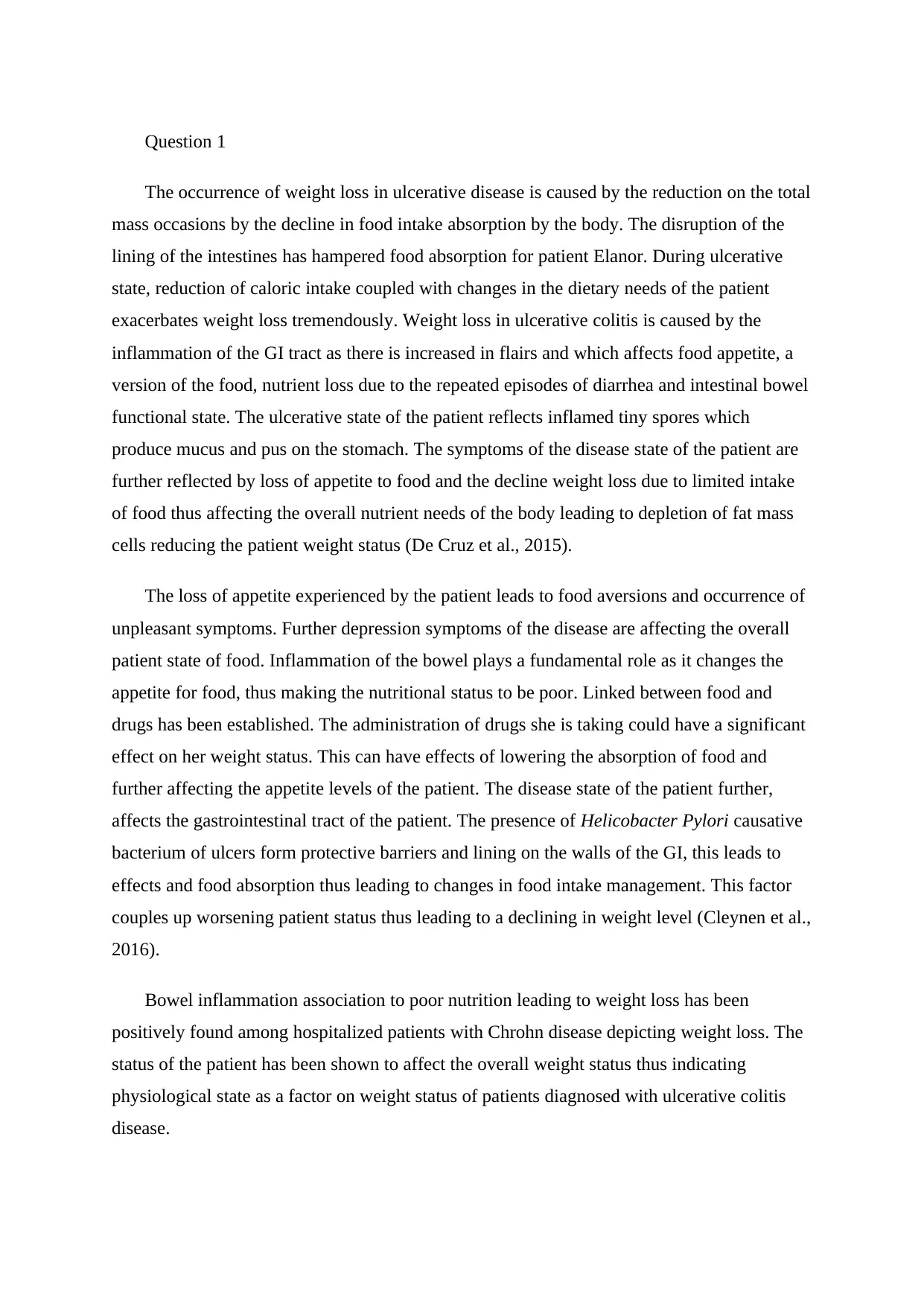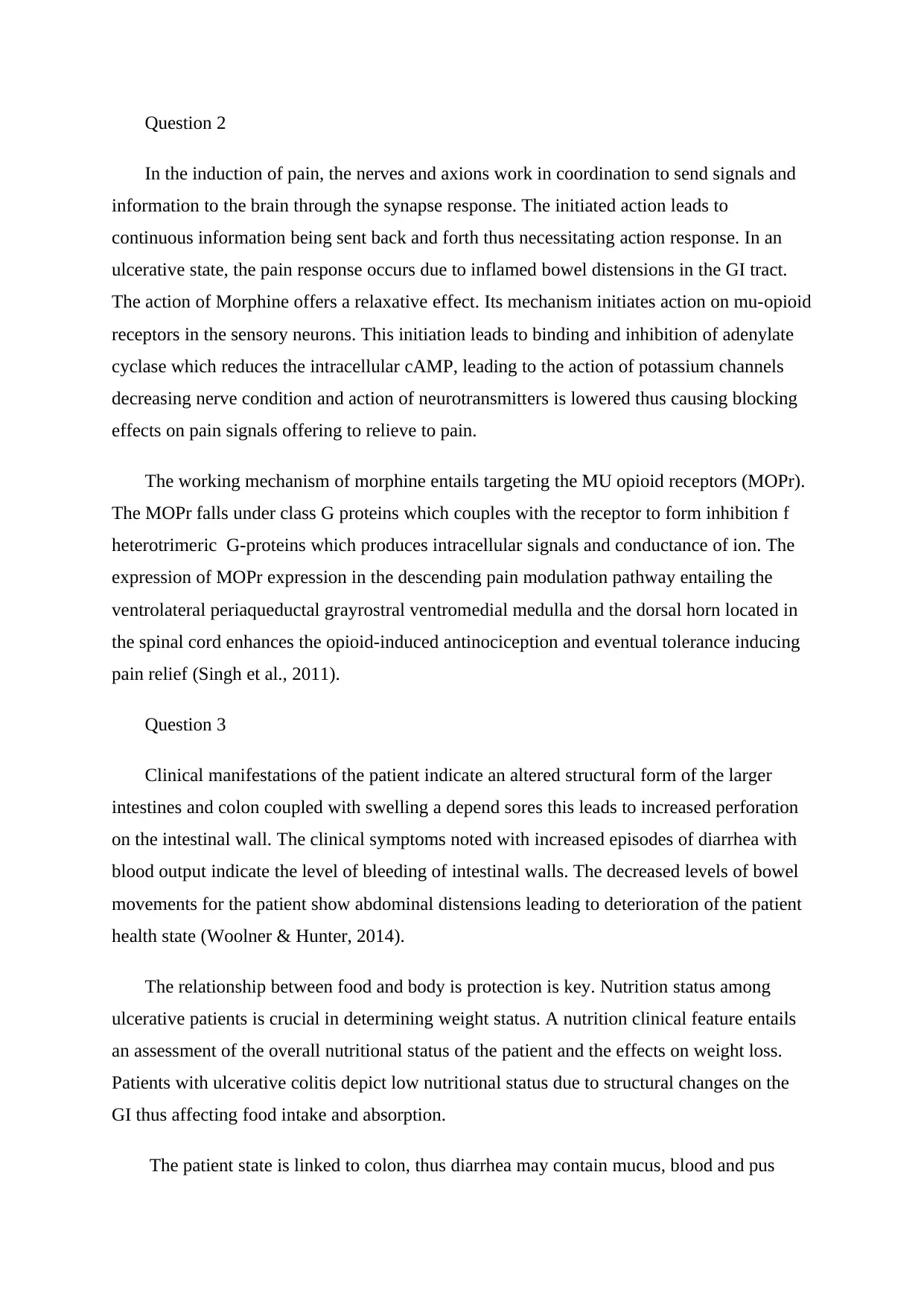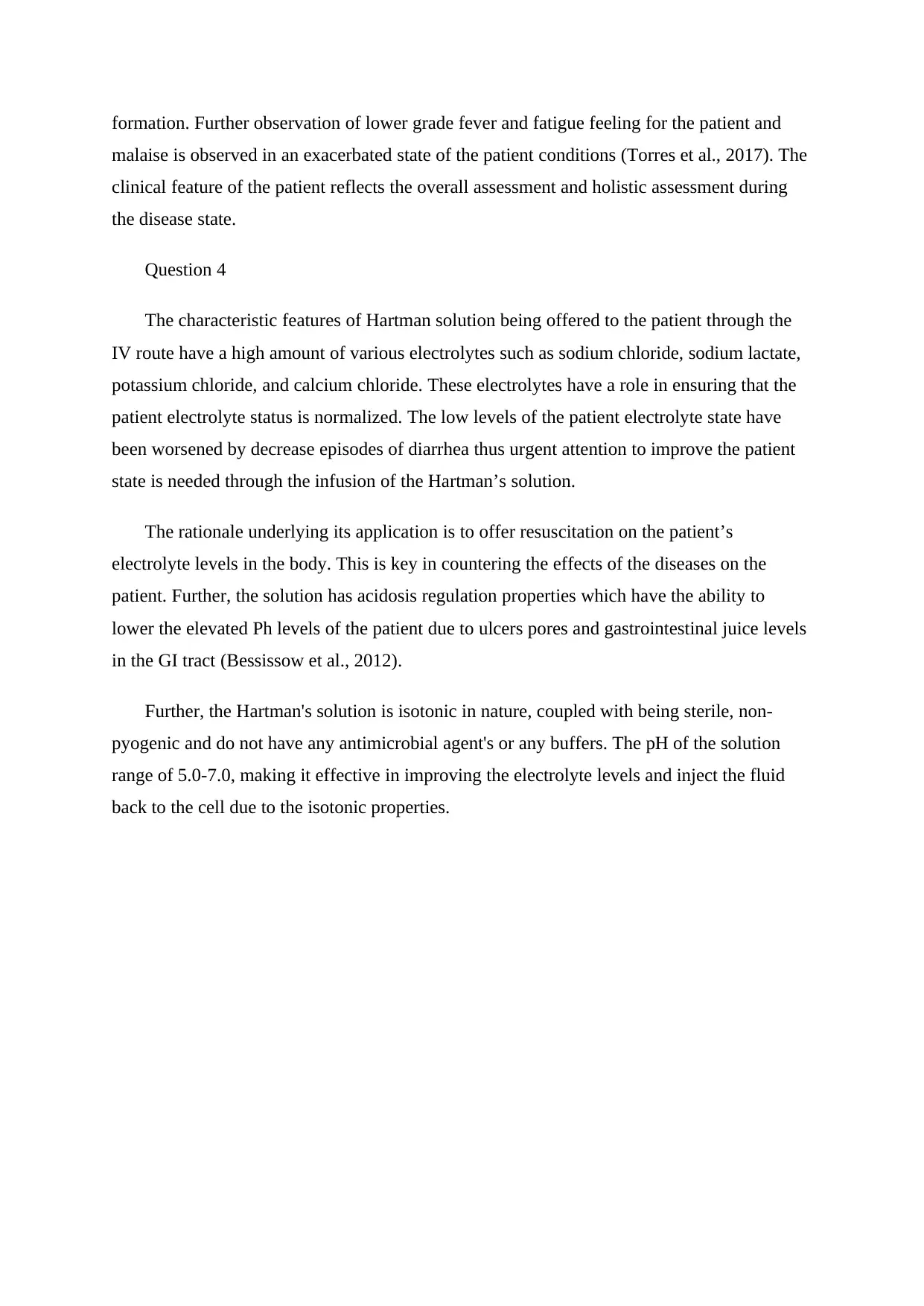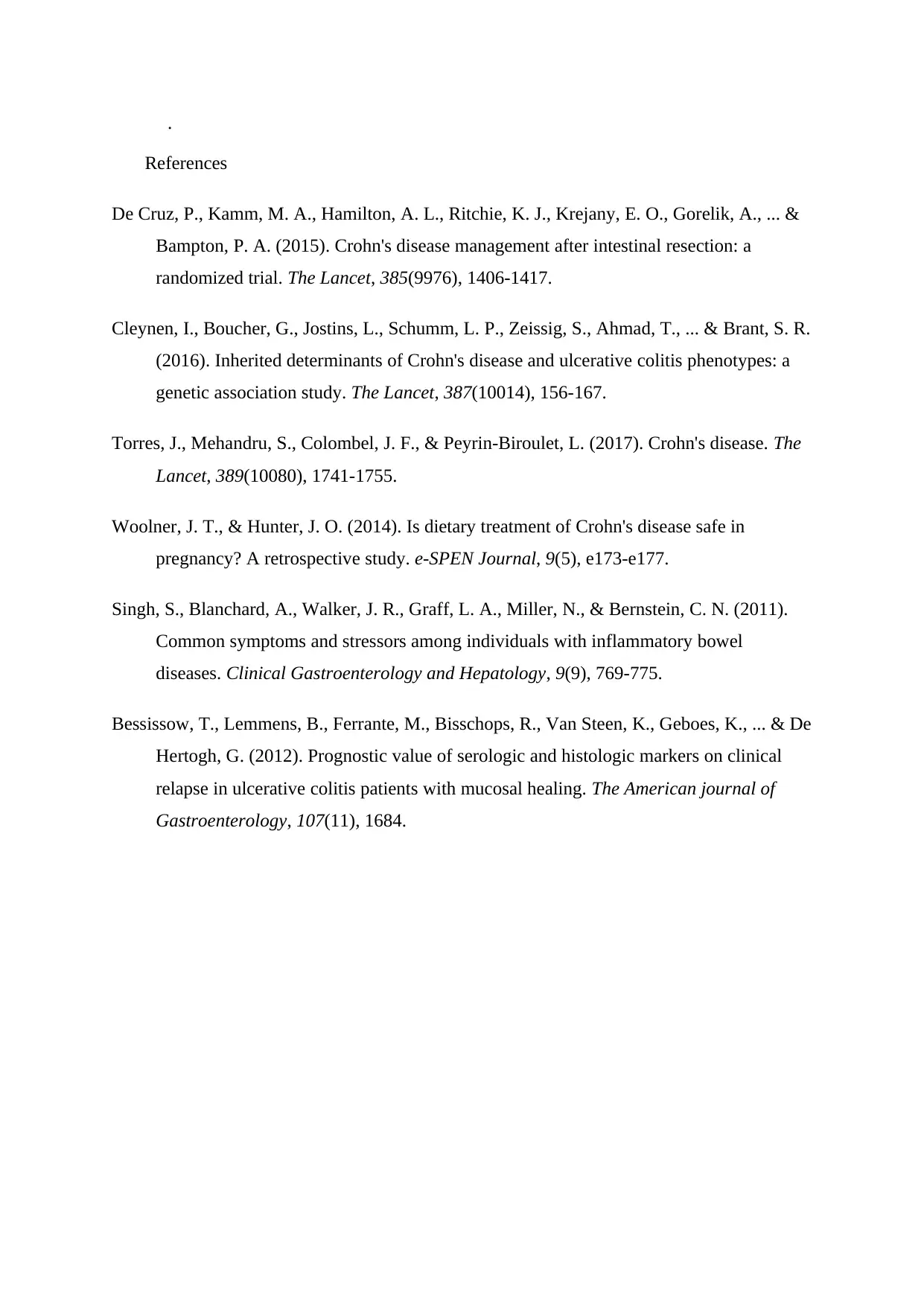In-depth Case Study: Analyzing Ulcerative Colitis Patient Management
VerifiedAdded on 2023/04/20
|5
|1418
|452
Case Study
AI Summary
This case study delves into the complexities of managing ulcerative colitis in a patient, focusing on the physiological factors contributing to weight loss, pain management strategies using morphine, and the clinical manifestations of the disease. It explores the impact of bowel inflammation on appetite and nutrient absorption, the role of medications, and the influence of Helicobacter pylori on the gastrointestinal tract. The study further examines the rationale behind using Hartman's solution to restore electrolyte balance and regulate acidosis, highlighting the importance of nutritional status in ulcerative colitis patients. Clinical features such as altered intestinal structure, diarrhea with blood, and fever are discussed, emphasizing the need for a holistic assessment. The document is available on Desklib, a platform offering a wealth of study resources, including past papers and solved assignments, to support students in their academic endeavors.

Case study Assesment
Name
Tutor
Date
Name
Tutor
Date
Paraphrase This Document
Need a fresh take? Get an instant paraphrase of this document with our AI Paraphraser

Question 1
The occurrence of weight loss in ulcerative disease is caused by the reduction on the total
mass occasions by the decline in food intake absorption by the body. The disruption of the
lining of the intestines has hampered food absorption for patient Elanor. During ulcerative
state, reduction of caloric intake coupled with changes in the dietary needs of the patient
exacerbates weight loss tremendously. Weight loss in ulcerative colitis is caused by the
inflammation of the GI tract as there is increased in flairs and which affects food appetite, a
version of the food, nutrient loss due to the repeated episodes of diarrhea and intestinal bowel
functional state. The ulcerative state of the patient reflects inflamed tiny spores which
produce mucus and pus on the stomach. The symptoms of the disease state of the patient are
further reflected by loss of appetite to food and the decline weight loss due to limited intake
of food thus affecting the overall nutrient needs of the body leading to depletion of fat mass
cells reducing the patient weight status (De Cruz et al., 2015).
The loss of appetite experienced by the patient leads to food aversions and occurrence of
unpleasant symptoms. Further depression symptoms of the disease are affecting the overall
patient state of food. Inflammation of the bowel plays a fundamental role as it changes the
appetite for food, thus making the nutritional status to be poor. Linked between food and
drugs has been established. The administration of drugs she is taking could have a significant
effect on her weight status. This can have effects of lowering the absorption of food and
further affecting the appetite levels of the patient. The disease state of the patient further,
affects the gastrointestinal tract of the patient. The presence of Helicobacter Pylori causative
bacterium of ulcers form protective barriers and lining on the walls of the GI, this leads to
effects and food absorption thus leading to changes in food intake management. This factor
couples up worsening patient status thus leading to a declining in weight level (Cleynen et al.,
2016).
Bowel inflammation association to poor nutrition leading to weight loss has been
positively found among hospitalized patients with Chrohn disease depicting weight loss. The
status of the patient has been shown to affect the overall weight status thus indicating
physiological state as a factor on weight status of patients diagnosed with ulcerative colitis
disease.
The occurrence of weight loss in ulcerative disease is caused by the reduction on the total
mass occasions by the decline in food intake absorption by the body. The disruption of the
lining of the intestines has hampered food absorption for patient Elanor. During ulcerative
state, reduction of caloric intake coupled with changes in the dietary needs of the patient
exacerbates weight loss tremendously. Weight loss in ulcerative colitis is caused by the
inflammation of the GI tract as there is increased in flairs and which affects food appetite, a
version of the food, nutrient loss due to the repeated episodes of diarrhea and intestinal bowel
functional state. The ulcerative state of the patient reflects inflamed tiny spores which
produce mucus and pus on the stomach. The symptoms of the disease state of the patient are
further reflected by loss of appetite to food and the decline weight loss due to limited intake
of food thus affecting the overall nutrient needs of the body leading to depletion of fat mass
cells reducing the patient weight status (De Cruz et al., 2015).
The loss of appetite experienced by the patient leads to food aversions and occurrence of
unpleasant symptoms. Further depression symptoms of the disease are affecting the overall
patient state of food. Inflammation of the bowel plays a fundamental role as it changes the
appetite for food, thus making the nutritional status to be poor. Linked between food and
drugs has been established. The administration of drugs she is taking could have a significant
effect on her weight status. This can have effects of lowering the absorption of food and
further affecting the appetite levels of the patient. The disease state of the patient further,
affects the gastrointestinal tract of the patient. The presence of Helicobacter Pylori causative
bacterium of ulcers form protective barriers and lining on the walls of the GI, this leads to
effects and food absorption thus leading to changes in food intake management. This factor
couples up worsening patient status thus leading to a declining in weight level (Cleynen et al.,
2016).
Bowel inflammation association to poor nutrition leading to weight loss has been
positively found among hospitalized patients with Chrohn disease depicting weight loss. The
status of the patient has been shown to affect the overall weight status thus indicating
physiological state as a factor on weight status of patients diagnosed with ulcerative colitis
disease.

Question 2
In the induction of pain, the nerves and axions work in coordination to send signals and
information to the brain through the synapse response. The initiated action leads to
continuous information being sent back and forth thus necessitating action response. In an
ulcerative state, the pain response occurs due to inflamed bowel distensions in the GI tract.
The action of Morphine offers a relaxative effect. Its mechanism initiates action on mu-opioid
receptors in the sensory neurons. This initiation leads to binding and inhibition of adenylate
cyclase which reduces the intracellular cAMP, leading to the action of potassium channels
decreasing nerve condition and action of neurotransmitters is lowered thus causing blocking
effects on pain signals offering to relieve to pain.
The working mechanism of morphine entails targeting the MU opioid receptors (MOPr).
The MOPr falls under class G proteins which couples with the receptor to form inhibition f
heterotrimeric G-proteins which produces intracellular signals and conductance of ion. The
expression of MOPr expression in the descending pain modulation pathway entailing the
ventrolateral periaqueductal grayrostral ventromedial medulla and the dorsal horn located in
the spinal cord enhances the opioid-induced antinociception and eventual tolerance inducing
pain relief (Singh et al., 2011).
Question 3
Clinical manifestations of the patient indicate an altered structural form of the larger
intestines and colon coupled with swelling a depend sores this leads to increased perforation
on the intestinal wall. The clinical symptoms noted with increased episodes of diarrhea with
blood output indicate the level of bleeding of intestinal walls. The decreased levels of bowel
movements for the patient show abdominal distensions leading to deterioration of the patient
health state (Woolner & Hunter, 2014).
The relationship between food and body is protection is key. Nutrition status among
ulcerative patients is crucial in determining weight status. A nutrition clinical feature entails
an assessment of the overall nutritional status of the patient and the effects on weight loss.
Patients with ulcerative colitis depict low nutritional status due to structural changes on the
GI thus affecting food intake and absorption.
The patient state is linked to colon, thus diarrhea may contain mucus, blood and pus
In the induction of pain, the nerves and axions work in coordination to send signals and
information to the brain through the synapse response. The initiated action leads to
continuous information being sent back and forth thus necessitating action response. In an
ulcerative state, the pain response occurs due to inflamed bowel distensions in the GI tract.
The action of Morphine offers a relaxative effect. Its mechanism initiates action on mu-opioid
receptors in the sensory neurons. This initiation leads to binding and inhibition of adenylate
cyclase which reduces the intracellular cAMP, leading to the action of potassium channels
decreasing nerve condition and action of neurotransmitters is lowered thus causing blocking
effects on pain signals offering to relieve to pain.
The working mechanism of morphine entails targeting the MU opioid receptors (MOPr).
The MOPr falls under class G proteins which couples with the receptor to form inhibition f
heterotrimeric G-proteins which produces intracellular signals and conductance of ion. The
expression of MOPr expression in the descending pain modulation pathway entailing the
ventrolateral periaqueductal grayrostral ventromedial medulla and the dorsal horn located in
the spinal cord enhances the opioid-induced antinociception and eventual tolerance inducing
pain relief (Singh et al., 2011).
Question 3
Clinical manifestations of the patient indicate an altered structural form of the larger
intestines and colon coupled with swelling a depend sores this leads to increased perforation
on the intestinal wall. The clinical symptoms noted with increased episodes of diarrhea with
blood output indicate the level of bleeding of intestinal walls. The decreased levels of bowel
movements for the patient show abdominal distensions leading to deterioration of the patient
health state (Woolner & Hunter, 2014).
The relationship between food and body is protection is key. Nutrition status among
ulcerative patients is crucial in determining weight status. A nutrition clinical feature entails
an assessment of the overall nutritional status of the patient and the effects on weight loss.
Patients with ulcerative colitis depict low nutritional status due to structural changes on the
GI thus affecting food intake and absorption.
The patient state is linked to colon, thus diarrhea may contain mucus, blood and pus
⊘ This is a preview!⊘
Do you want full access?
Subscribe today to unlock all pages.

Trusted by 1+ million students worldwide

formation. Further observation of lower grade fever and fatigue feeling for the patient and
malaise is observed in an exacerbated state of the patient conditions (Torres et al., 2017). The
clinical feature of the patient reflects the overall assessment and holistic assessment during
the disease state.
Question 4
The characteristic features of Hartman solution being offered to the patient through the
IV route have a high amount of various electrolytes such as sodium chloride, sodium lactate,
potassium chloride, and calcium chloride. These electrolytes have a role in ensuring that the
patient electrolyte status is normalized. The low levels of the patient electrolyte state have
been worsened by decrease episodes of diarrhea thus urgent attention to improve the patient
state is needed through the infusion of the Hartman’s solution.
The rationale underlying its application is to offer resuscitation on the patient’s
electrolyte levels in the body. This is key in countering the effects of the diseases on the
patient. Further, the solution has acidosis regulation properties which have the ability to
lower the elevated Ph levels of the patient due to ulcers pores and gastrointestinal juice levels
in the GI tract (Bessissow et al., 2012).
Further, the Hartman's solution is isotonic in nature, coupled with being sterile, non-
pyogenic and do not have any antimicrobial agent's or any buffers. The pH of the solution
range of 5.0-7.0, making it effective in improving the electrolyte levels and inject the fluid
back to the cell due to the isotonic properties.
malaise is observed in an exacerbated state of the patient conditions (Torres et al., 2017). The
clinical feature of the patient reflects the overall assessment and holistic assessment during
the disease state.
Question 4
The characteristic features of Hartman solution being offered to the patient through the
IV route have a high amount of various electrolytes such as sodium chloride, sodium lactate,
potassium chloride, and calcium chloride. These electrolytes have a role in ensuring that the
patient electrolyte status is normalized. The low levels of the patient electrolyte state have
been worsened by decrease episodes of diarrhea thus urgent attention to improve the patient
state is needed through the infusion of the Hartman’s solution.
The rationale underlying its application is to offer resuscitation on the patient’s
electrolyte levels in the body. This is key in countering the effects of the diseases on the
patient. Further, the solution has acidosis regulation properties which have the ability to
lower the elevated Ph levels of the patient due to ulcers pores and gastrointestinal juice levels
in the GI tract (Bessissow et al., 2012).
Further, the Hartman's solution is isotonic in nature, coupled with being sterile, non-
pyogenic and do not have any antimicrobial agent's or any buffers. The pH of the solution
range of 5.0-7.0, making it effective in improving the electrolyte levels and inject the fluid
back to the cell due to the isotonic properties.
Paraphrase This Document
Need a fresh take? Get an instant paraphrase of this document with our AI Paraphraser

.
References
De Cruz, P., Kamm, M. A., Hamilton, A. L., Ritchie, K. J., Krejany, E. O., Gorelik, A., ... &
Bampton, P. A. (2015). Crohn's disease management after intestinal resection: a
randomized trial. The Lancet, 385(9976), 1406-1417.
Cleynen, I., Boucher, G., Jostins, L., Schumm, L. P., Zeissig, S., Ahmad, T., ... & Brant, S. R.
(2016). Inherited determinants of Crohn's disease and ulcerative colitis phenotypes: a
genetic association study. The Lancet, 387(10014), 156-167.
Torres, J., Mehandru, S., Colombel, J. F., & Peyrin-Biroulet, L. (2017). Crohn's disease. The
Lancet, 389(10080), 1741-1755.
Woolner, J. T., & Hunter, J. O. (2014). Is dietary treatment of Crohn's disease safe in
pregnancy? A retrospective study. e-SPEN Journal, 9(5), e173-e177.
Singh, S., Blanchard, A., Walker, J. R., Graff, L. A., Miller, N., & Bernstein, C. N. (2011).
Common symptoms and stressors among individuals with inflammatory bowel
diseases. Clinical Gastroenterology and Hepatology, 9(9), 769-775.
Bessissow, T., Lemmens, B., Ferrante, M., Bisschops, R., Van Steen, K., Geboes, K., ... & De
Hertogh, G. (2012). Prognostic value of serologic and histologic markers on clinical
relapse in ulcerative colitis patients with mucosal healing. The American journal of
Gastroenterology, 107(11), 1684.
References
De Cruz, P., Kamm, M. A., Hamilton, A. L., Ritchie, K. J., Krejany, E. O., Gorelik, A., ... &
Bampton, P. A. (2015). Crohn's disease management after intestinal resection: a
randomized trial. The Lancet, 385(9976), 1406-1417.
Cleynen, I., Boucher, G., Jostins, L., Schumm, L. P., Zeissig, S., Ahmad, T., ... & Brant, S. R.
(2016). Inherited determinants of Crohn's disease and ulcerative colitis phenotypes: a
genetic association study. The Lancet, 387(10014), 156-167.
Torres, J., Mehandru, S., Colombel, J. F., & Peyrin-Biroulet, L. (2017). Crohn's disease. The
Lancet, 389(10080), 1741-1755.
Woolner, J. T., & Hunter, J. O. (2014). Is dietary treatment of Crohn's disease safe in
pregnancy? A retrospective study. e-SPEN Journal, 9(5), e173-e177.
Singh, S., Blanchard, A., Walker, J. R., Graff, L. A., Miller, N., & Bernstein, C. N. (2011).
Common symptoms and stressors among individuals with inflammatory bowel
diseases. Clinical Gastroenterology and Hepatology, 9(9), 769-775.
Bessissow, T., Lemmens, B., Ferrante, M., Bisschops, R., Van Steen, K., Geboes, K., ... & De
Hertogh, G. (2012). Prognostic value of serologic and histologic markers on clinical
relapse in ulcerative colitis patients with mucosal healing. The American journal of
Gastroenterology, 107(11), 1684.
1 out of 5
Related Documents
Your All-in-One AI-Powered Toolkit for Academic Success.
+13062052269
info@desklib.com
Available 24*7 on WhatsApp / Email
![[object Object]](/_next/static/media/star-bottom.7253800d.svg)
Unlock your academic potential
Copyright © 2020–2025 A2Z Services. All Rights Reserved. Developed and managed by ZUCOL.





